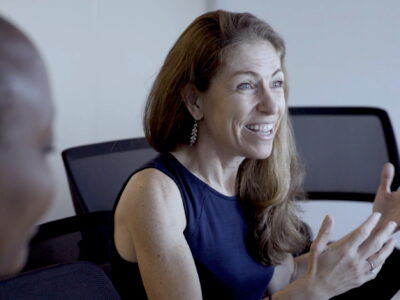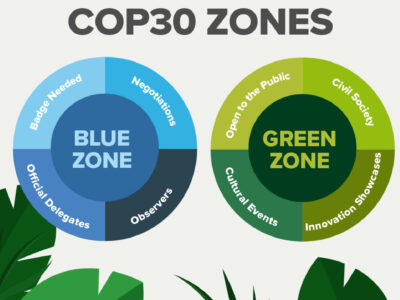
left, wears a true “panama
hat” in Santa Clara, Panama in July 2005. Hats
like this are the primary source of income for the community
and are made from native grass. Don Mateo, at right, a member
of the Patronato Sustainable Agriculture Program, holds the
beginings of hat.
Economists, physicians and a range of social scientists have long found an easy place at the table when it comes to promoting sustainable development in the poorest areas of the world. But an agroecologist?
“Agroecologists always feel a little outcast when working on development issues,” says Fabrice De Clerck, an Earth Institute Fellow with the Center for Environmental Research and Conservation (CERC). But that is changing.
Today, projects like the Millennium Villages Project are putting ecologists, particularly agroforestry specialists, to critical use in combatting hunger and poverty by helping entire villages to have more robust crops and healthier soils. De Clerck is working with the Project researching the practical applications of ecological theory to help villages thrive.
Originally from Belgium, De Clerck says his journey to becoming an agroecologist began many years ago when he was just a teenager on a bike ride from his native country to Africa. “I always knew I wanted to do something to help people, but I also wanted to be in nature. So I grew up thinking I would be a nurse or park ranger,” he recalls. On this trip, De Clerck learned about desertification and the complex ecology of Africa by reading The Greening of Africa, where he first read about Pedro Sanchez and Cheryl Palm, both Earth Institute experts in soil science who have made agroecology a central component of the Earth Institute’s Millennium Villages Project, proving its crucial role in sustainable development.
Today, this young researcher has come full circle since that trek through Africa. As an EI Fellow working closely with Palm at a Millennium Villages site in Sauri, Kenya, he is applying his knowledge of agricultural biodiversity directly to help villagers “reach the Millennium Development Goals.”
For the first six months of his fellowship, De Clerck was based in New York but soon developed an itch to get to Sauri and see how science was making a real impact on the ground. “My experience was intense—to see firsthand the role of ecology in achieving the MDGs. People are hungry part of the year, but Sauri is not barren; it is green and diverse. There’s hope.”
De Clerck, his wife and their newborn son will pick up stakes in Januray to live in Kenya where he will finish his fellowship. In Sauri, he will look specifically at how species can be combined to create agricultural systems that are more productivity, more resistant to droughts, pest outbreaks and diseases,while providing essential services such as meeting the villagers’ nutritional needs while maintaining the ecological integrity of the community.
“I need to be in the field to help people directly. I love working on something that is idealistic. I’m living a dream. Going to Sauri is the culmination of a dream that started 13 years ago on that bike ride.”
De Clerck has long felt that the science of sustainable agriculture can make a stronger and more substantial contribution to development. But to do so, he says, ecology needs to form the foundation. As an undergraduate, he rooted himself in the study of ecology at Humboldt State University where, surrounded by Redwood forests, he become more intimate with the plant sciences. He later earned a Master’s in Plant Biology from Iowa State and a Ph.D. in plant ecology from the University of California. His doctoral studies led him to the Sierra Nevada, where he studied how diverse plant communities impact the productivity of a specific site. “I learned that individual traits of plants are important. Plant traits can be brought together to compliment each other and make more productive plant communities.”
De Clerck was recently honored this summer by the Association for International Agriculture and Rural Development (AIARD) with its Young Professional Award given “in recognition of commitment to and advocacy for international agricultural development and contribution to improving the quality of life for the world’s poor.” The AIARD Young Professional Award was established in 1990 to recognize early career contributions to the goals and objectives of the association.



